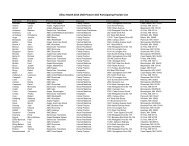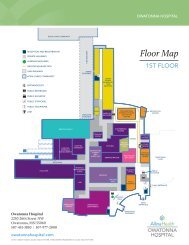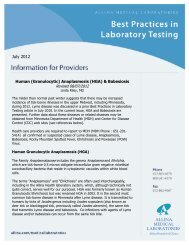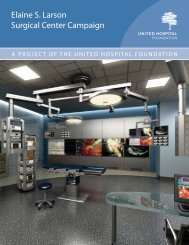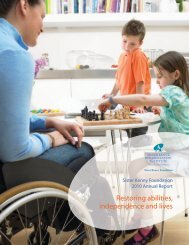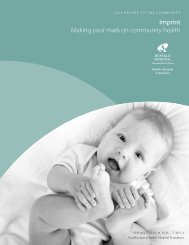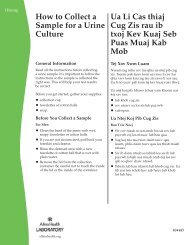Swab & Urine Collection Instructions - Allina Health
Swab & Urine Collection Instructions - Allina Health
Swab & Urine Collection Instructions - Allina Health
Create successful ePaper yourself
Turn your PDF publications into a flip-book with our unique Google optimized e-Paper software.
GC and Chlamydia trachomatis<br />
Probe <strong>Collection</strong><br />
Specimen <strong>Collection</strong> for Neisseria gonorrhoeae<br />
and/or Chlamydia trachomatis<br />
Specimen<br />
Chlamydia trachomatis Probe<br />
versus Patient Infected Status<br />
October 2012<br />
Neisseria gonorrhoeae Probe<br />
versus Patient Infected Status<br />
Sensitivity (%) Specificity (%) Sensitivity (%) Specificity (%)<br />
Female endocervical swab 94.2 97.6 99.2 98.7<br />
Female urine 94.7 98.9 91.3 99.3<br />
Female vaginal 97.2 94.9 97.3 99.2<br />
Male urethral swab 95.9 97.5 99.1 97.8<br />
Male urine 97.9 98.5 98.5 99.6<br />
Overall 95.9 98.2 97.8 98.9<br />
SPECIMENS AND CONTAINERS:<br />
Specimens tested at <strong>Allina</strong> <strong>Health</strong> Laboratory:<br />
Vaginal: Aptima Vaginal <strong>Swab</strong> Specimen <strong>Collection</strong> Kit<br />
(pink-shafted swab)<br />
Endocervical: Aptima Unisex <strong>Swab</strong> Specimen <strong>Collection</strong> Kit<br />
(blue-shafted swab)<br />
Male Urethral: Aptima Unisex <strong>Swab</strong> Specimen <strong>Collection</strong> Kit<br />
(blue-shafted swab)<br />
Male/Female<br />
<strong>Urine</strong>: Aptima <strong>Urine</strong> Specimen <strong>Collection</strong> Kit<br />
Hysterectomy<br />
patients: Collect vaginal or urine specimen.<br />
Specimens referred to Mayo Medical Laboratories (MML):<br />
Eye, Rectal: Collect MAYO Aptima Unisex <strong>Swab</strong>, refrigerated.<br />
Order Chlamydia trachomatis & GC - Eye/Rectal (8274/GCR).<br />
Ocular, Oral,<br />
Mouth, Throat: Collect MAYO Aptima Unisex <strong>Swab</strong>, refrigerated.<br />
Order Chlamydia trachomatis-Other Sources (8270/CTO).<br />
Order Neisseria gonorrhoeae, Miscellaneous Sites (994/MSO).<br />
Peritoneal Fluid<br />
(Pelvic Wash,<br />
Cul de Sac Fluid): Collect MAYO Aptima Unisex <strong>Swab</strong>, refrigerated.<br />
Order Neisseria gonorrhoeae, Miscellaneous Sites (994/MSO)
Unacceptable:<br />
• No swab, white swab, or two swabs in Aptima swab transport tube<br />
• <strong>Swab</strong> not from Aptima Unisex swab collection kit<br />
• Pink-shafted swab for cervical, endocervical, or urethral source<br />
• Blue-shafted swab for vaginal source<br />
• <strong>Collection</strong> from vaginal cuff<br />
• <strong>Urine</strong> transport tube not filled to “Fill Area” (above or below – rejected)<br />
• <strong>Urine</strong> not in Aptima transport tube (Client may transfer urine to Transport<br />
Tube within 24 hr. of collection. Due to nucleic acid cross-contamination<br />
issues, this must be done at the client site and will not be done at<br />
<strong>Allina</strong> <strong>Health</strong> Laboratory. If the urine has not been opened in the lab, it may<br />
be returned to the client to be transferred to the transport tube; otherwise,<br />
recollect.)<br />
• Frozen specimens<br />
• Sources other than female endocervical, vaginal, male urethral, or voided urine,<br />
or sources acceptable at Mayo (see above).<br />
TRANSPORT: Ambient or refrigerated.<br />
<strong>Swab</strong> in transport within 60 days; <strong>Urine</strong> in transport tube within 30 days.<br />
SPECIMEN COLLECTION<br />
The following instructions are provided on the kit packages.<br />
Female Endocervical <strong>Swab</strong> Specimens:<br />
Use Aptima Unisex <strong>Swab</strong> Specimen <strong>Collection</strong> Kit. Specimen will be rejected if collected<br />
with Aptima Vaginal <strong>Swab</strong> Specimen <strong>Collection</strong> Kit.<br />
1. Remove excess mucus from cervical os and surrounding mucosa using cleaning<br />
swab (white shaft swab in package with red printing). Discard the white<br />
swab.<br />
2. Insert specimen collection swab (blue shaft swab in package with green<br />
printing) into endocervical canal.<br />
3. Gently rotate swab clockwise for 10 to 30 seconds in endocervical canal to<br />
ensure adequate sampling.<br />
4. Withdraw swab carefully; avoid any contact with vaginal mucosa.<br />
5. Remove cap from swab specimen transport tube and immediately place<br />
specimen collection swab into specimen transport tube.<br />
6. Carefully break swab shaft at score line and discard the top portion of the swab<br />
shaft; use care to avoid splashing contents.<br />
7. Re-cap swab specimen transport tube tightly.<br />
November 2012
Female Vaginal Specimens<br />
Option when a pelvic exam is not otherwise indicated for clinician or patient-collected<br />
specimen. Not for home use. Patient collection is limited to health care facilities where<br />
support/counseling is available to explain procedures and precautions.)<br />
Use Aptima Vaginal <strong>Swab</strong> Specimen <strong>Collection</strong> Kit. Specimen will be rejected if<br />
collected with Aptima Unisex <strong>Swab</strong> Specimen <strong>Collection</strong> Kit.<br />
1. Partially peel open the swab package. Remove the swab. Do not touch the soft<br />
tip or lay the swab down. If the soft tip is touched, the swab is laid down, or the<br />
swab is dropped, use a new Aptima Vaginal <strong>Swab</strong> Specimen <strong>Collection</strong> Kit.<br />
2. Hold the swab, placing your thumb and forefinger in the middle of the swab<br />
shaft covering the score line. Do not hold the swab shaft below the score line.<br />
3. Carefully insert the swab into the vagina about 2 inches past the introitus and<br />
gently rotate the swab for 10 to 30 seconds. Make sure the swab touches the<br />
walls of the vagina so that moisture is absorbed by the swab and then withdraw<br />
the swab without touching the skin.<br />
4. While holding the swab in the same hand, unscrew the cap from the tube. Do<br />
not spill the contents of the tube. If the contents of the tube are spilled, use a<br />
new Aptima Vaginal swab Specimen <strong>Collection</strong> Kit.<br />
5. Immediately place the swab into the transport tube so that the score line is at<br />
the top of the tube.<br />
6. Carefully break the swab shaft at the score line against the side of the tube.<br />
7. Immediately discard the top portion of the swab shaft.<br />
8. Tightly screw the cap onto the tube.<br />
Male Urethral <strong>Swab</strong> Specimens:<br />
Patient should not have urinated for at least 1 hour prior to specimen collection.<br />
1. Insert specimen collection swab (blue shaft swab in package with green<br />
printing) 2 to 4 cm into urethra.<br />
2. Gently rotate swab clockwise for 2 to 3 seconds in urethra to ensure adequate<br />
sampling. Withdraw swab carefully.<br />
3. Remove cap from swab specimen transport tube and immediately place<br />
specimen collection swab into specimen transport tube.<br />
4. Carefully break swab shaft at score line and discard the top portion of the swab<br />
shaft; use care to avoid splashing contents.<br />
5. Re-cap the swab specimen transport tube tightly.<br />
November 2012
Male and Female <strong>Urine</strong> Specimens:<br />
Patient should not have urinated for at least 1hr prior to specimen collection.<br />
Female patients should not cleanse labial area prior to providing the specimen.<br />
1. Direct patient to provide first-catch urine (approximately 20 to 30 ml of initial<br />
urine stream) into urine collection cup free of any preservatives. <strong>Collection</strong> of<br />
larger volumes of urine may result in specimen dilution that may reduce test<br />
sensitivity.<br />
2. Remove cap from urine specimen transport tube and transfer 2ml of urine into<br />
urine specimen transport tube using disposable pipette provided. The correct<br />
volume of urine has been added when fluid level is between black fill lines on<br />
urine specimen transport tube label.<br />
3. If refrigerated, urine may be transferred to the transport tube at the collection<br />
site within 24 hr.<br />
4. Re-cap urine specimen transport tube tightly.<br />
METHOD LIMITATIONS<br />
• Mucus should be removed before collection of endocervical specimens to ensure collection<br />
of endocervical epithelial cells infected with C. trachomatis.<br />
• Blood, lubricants, spermicides do NOT interfere with the test.<br />
• Vaginal swab sampling is not designed to replace cervical exams and endocervical<br />
specimens for diagnosis of urogenital infections and pelvic inflammatory disease, as these<br />
may be caused by other organisms.<br />
• The performance of vaginal swab specimens has not been evaluated in pregnant women or<br />
females less than 16 years of age.<br />
• After treatment, nucleic acid may persist following appropriate antimicrobial therapy. Except<br />
in pregnant women, GC and Chlamydia test-of-cure (i.e. repeat testing 3-4 weeks after<br />
completing therapy) is not recommended for persons treated with the recommended or<br />
alternative regimens, unless therapeutic compliance is in question, symptoms persist, or<br />
reinfection is suspected. If symptoms persist after treatment in cases of gonorrhea, evaluate<br />
with GC culture.<br />
• Repeat DNA probe testing for Chlamydia and Neisseria gonorrhoeae is recommended by<br />
CDC approximately 3 months after treatment to detect reinfection. This is distinct from<br />
retesting for test-of-cure to detect therapeutic failure, which is not recommended by CDC.<br />
• Detection is dependent on the quantity of organisms present in the specimen. This is<br />
influenced by patient factors, stage of infection, organism strain, and adequate specimen<br />
collection.<br />
November 2012




